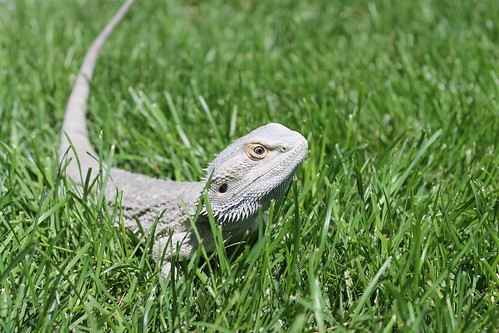The whiteness of the legs of your bearded dragon may be due to shedding, which occurs several times during the life of the bearded dragon, especially when it is young and growing quickly.
As beardies get older, they begin to shed less regularly, and that is the most common cause of turning white. Shedding is the most common cause of turning white among beardies, and it is a natural part of the process.
During shedding, the white coloration on the bearded dragon’s legs, head, and tail is caused by a pigment called pterin. Pterin is found in all bearded dragons and is responsible for their white coloration.
Make sure your bearded dragon has a large water bowl and a moist hide in case its legs have turned white due to shedding.
You can also give your bearded dragon a bath to remove old skin. Allow it to soak for 25 to 30 minutes before rubbing it into the skin. You can also use an emollient shedding aid to hydrate the skin.
Causes of White Legs in Bearded Dragons
Shedding Process and Its Effects on Leg Coloration
Bearded dragons, like other reptiles, shed their skin periodically. During the shedding process, they may experience temporary changes in their appearance, including white legs.
Shedding occurs as the bearded dragon grows and needs to replace its old skin with a new layer. As the shedding process begins, the top layer of scales will start to lift away from the underlying layers.
The new skin underneath is often lighter or whiter in color than the old skin that’s being shed. This can cause temporary patches of white on their legs or other parts of their body until the entire process is complete.
Common Nutritional Deficiencies in Bearded Dragons
Nutrition plays a vital role in keeping your bearded dragon healthy and free from various health issues. A lack of specific vitamins and minerals can cause several problems in bearded dragons, including white legs.
Common nutritional deficiencies include calcium, vitamin D3, and phosphorus deficiencies that can lead to metabolic bone disease (MBD). MBD can cause a range of symptoms seen in bearded dragons with white limbs such as leg weakness or paralysis, loss of appetite, or energy levels.
How These Deficiencies Can Cause White Legs?
When your bearded dragon has a deficiency in nutrients like calcium, it affects its bone strength and density which leads to MBD which further causes white spots on limbs along with other symptoms like lethargy and bone deformities. Calcium deficiency is one of the most common causes responsible for MBD development.
When calcium levels are not sufficient for use during normal daily activities such as muscle contraction or nerve signaling processes – then calcium ions must be taken from bones’ storage sites instead leading to brittle bones that are prone to fractures due to weakened structure.
Treatment for White Legs in Bearded Dragons
Home remedies for treating white legs
If your bearded dragon has developed white legs, there are a few home remedies that you can try before seeking veterinary treatment. One option is to give your bearded dragon a warm water bath.
This can help to soften the skin, making it easier for any shedding to occur and thus reducing the likelihood of white marks being left behind. You can also try applying a small amount of petroleum jelly or coconut oil to the affected area, as this can help to moisturize and soothe the skin.
Another home remedy to consider is increasing the humidity in your bearded dragon’s enclosure. This can be achieved by adding a humidifier or spray bottle to their environment.
Providing a damp towel on one side of their enclosure may also help increase humidity levels. Dryness can exacerbate skin conditions, so increasing humidity may improve leg coloration.
Veterinary treatment options
If home remedies do not resolve white legs in your bearded dragon, it is important to take them to see a veterinarian who specializes in reptiles for further evaluation and treatment options. The veterinarian will conduct a thorough physical examination and assess other factors such as diet and environmental conditions in order to identify any contributing factors causing white legs.
Treatment options may include administering vitamin or mineral supplements if deficiencies are identified through bloodwork analysis taken by the vet, and prescribing medicated baths or ointments depending on the severity of the condition.
It’s worth noting that early intervention often leads to successful resolution of leg discoloration issues in bearded dragons; ignoring such signs could lead to more severe health complications down the line.
Prevention Tips for White Legs in Bearded Dragons
Proper Diet Recommendations
A bearded dragon’s diet plays a crucial role in maintaining healthy skin and leg coloration. It is essential to provide a balanced diet rich in nutrients, vitamins, and minerals. Offer your pet a variety of vegetables like collard greens, kale, carrots, and squash.
Also, insects such as crickets and mealworms should only serve as a small portion of their diet. Avoid giving them high-fat foods or excessive calcium supplements as they can negatively impact the shedding process and cause white legs.
Hydration Tips
Providing adequate water is vital to your bearded dragon’s health. Ensure that they have access to fresh water at all times.
You may also mist them with water using a spray bottle several times a day to keep them hydrated. Additionally, soaking your pet in lukewarm water once a week can also boost hydration levels while helping with proper shedding.
Environmental Factors That Can Help Prevent White Legs
The environment you create for your bearded dragon can significantly affect its overall health and skin coloration.
Ensure the terrarium or enclosure is large enough for exercise and exploration while allowing for adequate heat and humidity levels that match their natural habitat conditions. Provide hiding spots, and basking areas with appropriate lighting to help regulate metabolism rates while promoting healthy shedding patterns.
Taking care of your beloved bearded dragon includes providing quality food rich in nutrients while ensuring proper hydration through frequent misting or soaking baths; creating an optimal environment with appropriate temperature and humidity levels also plays a vital role in preventing white legs from occurring.
Conclusion
After reviewing the potential causes and treatments for white legs in bearded dragons, it is essential to emphasize the importance of monitoring your pet’s health regularly.
As a responsible pet owner, you must maintain a balanced diet and ensure that your beardie receives proper hydration levels. Regular visits to the veterinarian can help identify any nutrient deficiencies early on and prevent further health complications.
Summary of key points discussed
Throughout this article, we’ve explored how shedding and nutritional deficiencies can cause white legs in bearded dragons. Shedding is a natural process that results in changes in coloration on different parts of their bodies, including their legs.
Nutrient deficiencies, such as calcium or vitamin D3 deficiencies, can have significant impacts on your beardie’s leg coloration. We’ve also looked at various treatment options that range from home remedies to professional veterinary care.
The importance of monitoring your pet’s health
Bearded dragons require specific care and attention to maintain good health. Monitoring their diet and hydration levels is vital to prevent nutrient deficiencies that could lead to several health issues, including white legs. Regular visits with a qualified reptile veterinarian can help identify any issues with your beardie’s overall health early on before they become more severe problems.
Remember that bearded dragons are social animals who crave attention from their owners. Providing them with proper nutrition and care will allow them to live long, healthy lives while bringing joy to yours as well!


